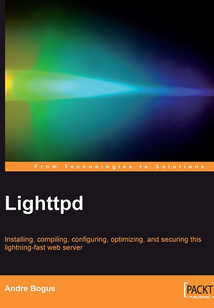- W 更新時間:2021-08-25 18:06:46
- V
- T
- S
- R
- P
- O
- M
- L
- K
- I
- H
- F
- D
- C
- A
- Index
- mod_webdav
- mod_usertrack
- mod_userdir
- mod_uploadprogress
- mod_trigger_b4_dl
- mod_status
- mod_staticfile
- mod_ssi
- mod_sql_vhost_core mod_mysql_vhost
- mod_simple_vhost
- mod_setenv
- mod_secure_download
- mod_scgi
- mod_rrdtool
- mod_rewrite
- mod_redirect
- mod_proxy_core
- mod_proxy
- mod_magnet
- mod_indexfile
- mod_flv_streaming
- mod_fastcgi
- mod_expire
- mod_evhost
- mod_evasive
- mod_dirlisting
- mod_deflate
- mod_compress
- mod_chunked
- mod_cml
- mod_cgi
- mod_auth
- mod_alias
- mod_accesslog
- mod_access
- Internal
- Appendix B. Module/Configuration Index
- Appendix A. HTTP Status Codes
- Summary
- Manipulating the Response
- Rewriting the Request
- Handling Configuration
- Chapter 13. Writing Lighttpd Modules
- Summary
- Example: A Shoutbox
- Running mod_magnet
- Lua/FastCGI
- Useful Lua Libraries
- Lua: A small Primer
- Chapter 12. Using Lua with Lighttpd
- Summary
- AjaxTerm
- AWStats
- Trac
- MediaWiki
- phpMyAdmin
- WordPress
- Ruby on Rails
- Chapter 11. CGI Revisited
- Summary
- WebDAV
- Rewriting Rules
- .htaccess
- mod_perl mod_php and mod_python
- Reducing Apache Load
- Excursion: mod_proxy
- Adding Lighttpd to the Mix
- Chapter 10. Migration from Apache
- Summary
- Profiling with gprof
- Specific Optimizations
- Installing http_load
- Chapter 9. Optimizing Lighttpd
- Summary
- Separating the Backend
- Changing Root
- Giving up Privileges
- Chapter 8. Containing Lighttpd
- Summary
- Know Your Foe
- Evading Denial of Service Attacks
- Barriers to Entry
- Chapter 7. Securing Lighttpd
- Summary
- Configuring Lighttpd to use SSL
- Obtaining a Key Pair from a Third-Party Supplier
- Being our own Certificate Authority
- Self-Signed Keys
- Chapter 6. Encryption: SSL
- Summary
- Other Data Points
- Tracking Users
- Access Logging
- O Browser Where Art Thou?
- Privacy
- Chapter 5. Big Brother Lighttpd
- Summary
- Putting it All Together
- Streaming Content
- Securing Downloads
- Showing Directory Contents
- Traffic Shaping
- Core Settings
- Chapter 4. Downloads and Streams
- Summary
- mod_proxy_core and backends
- SCGI
- FastCGI
- CGI with mod_cgi
- Going Dynamic
- MySQL based Virtual Hosting
- Extended Virtual Hosting
- Chapter 3. More Virtual Hosting and CGI
- Summary
- Including Variables Files and Shell-code
- Rewriting and Redirecting Requests
- Selectors
- Mime Types
- Other Core Options
- Starting Lighttpd by Hand
- Chapter 2. Configuring and Running Lighttpd
- Summary
- Building Lighttpd using CMake
- Building Lighttpd using Autotools
- Installing Lighttpd
- Chapter 1. Introduction to Lighttpd
- Customer Support
- Reader Feedback
- Conventions
- Who is This Book For
- What You Need For this Book
- What This Book Covers
- Preface
- About the Reviewer
- About the Author
- Credits
- Lighttpd
- 封面
- 封面
- Lighttpd
- Credits
- About the Author
- About the Reviewer
- Preface
- What This Book Covers
- What You Need For this Book
- Who is This Book For
- Conventions
- Reader Feedback
- Customer Support
- Chapter 1. Introduction to Lighttpd
- Installing Lighttpd
- Building Lighttpd using Autotools
- Building Lighttpd using CMake
- Summary
- Chapter 2. Configuring and Running Lighttpd
- Starting Lighttpd by Hand
- Other Core Options
- Mime Types
- Selectors
- Rewriting and Redirecting Requests
- Including Variables Files and Shell-code
- Summary
- Chapter 3. More Virtual Hosting and CGI
- Extended Virtual Hosting
- MySQL based Virtual Hosting
- Going Dynamic
- CGI with mod_cgi
- FastCGI
- SCGI
- mod_proxy_core and backends
- Summary
- Chapter 4. Downloads and Streams
- Core Settings
- Traffic Shaping
- Showing Directory Contents
- Securing Downloads
- Streaming Content
- Putting it All Together
- Summary
- Chapter 5. Big Brother Lighttpd
- Privacy
- O Browser Where Art Thou?
- Access Logging
- Tracking Users
- Other Data Points
- Summary
- Chapter 6. Encryption: SSL
- Self-Signed Keys
- Being our own Certificate Authority
- Obtaining a Key Pair from a Third-Party Supplier
- Configuring Lighttpd to use SSL
- Summary
- Chapter 7. Securing Lighttpd
- Barriers to Entry
- Evading Denial of Service Attacks
- Know Your Foe
- Summary
- Chapter 8. Containing Lighttpd
- Giving up Privileges
- Changing Root
- Separating the Backend
- Summary
- Chapter 9. Optimizing Lighttpd
- Installing http_load
- Specific Optimizations
- Profiling with gprof
- Summary
- Chapter 10. Migration from Apache
- Adding Lighttpd to the Mix
- Excursion: mod_proxy
- Reducing Apache Load
- mod_perl mod_php and mod_python
- .htaccess
- Rewriting Rules
- WebDAV
- Summary
- Chapter 11. CGI Revisited
- Ruby on Rails
- WordPress
- phpMyAdmin
- MediaWiki
- Trac
- AWStats
- AjaxTerm
- Summary
- Chapter 12. Using Lua with Lighttpd
- Lua: A small Primer
- Useful Lua Libraries
- Lua/FastCGI
- Running mod_magnet
- Example: A Shoutbox
- Summary
- Chapter 13. Writing Lighttpd Modules
- Handling Configuration
- Rewriting the Request
- Manipulating the Response
- Summary
- Appendix A. HTTP Status Codes
- Appendix B. Module/Configuration Index
- Internal
- mod_access
- mod_accesslog
- mod_alias
- mod_auth
- mod_cgi
- mod_cml
- mod_chunked
- mod_compress
- mod_deflate
- mod_dirlisting
- mod_evasive
- mod_evhost
- mod_expire
- mod_fastcgi
- mod_flv_streaming
- mod_indexfile
- mod_magnet
- mod_proxy
- mod_proxy_core
- mod_redirect
- mod_rewrite
- mod_rrdtool
- mod_scgi
- mod_secure_download
- mod_setenv
- mod_simple_vhost
- mod_sql_vhost_core mod_mysql_vhost
- mod_ssi
- mod_staticfile
- mod_status
- mod_trigger_b4_dl
- mod_uploadprogress
- mod_userdir
- mod_usertrack
- mod_webdav
- Index
- A
- C
- D
- F
- H
- I
- K
- L
- M
- O
- P
- R
- S
- T
- V
- W 更新時間:2021-08-25 18:06:46



